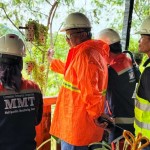Host town of TVIRD’s mining operations still province’s rice granary
del Norte, besting other rice producing towns in the province such as Labason,
Sindangan, Polanco, and even provincial capital Dipolog City last year. According
to Municipal Agriculturist Jonathan Jaron, Siocon’s feat was announced
by the Department of Agriculture in Region 9 during a meeting of local government
agriculturists in Dipolog recently, thus giving further boost to Siocon’s
reputation as the rice granary of the Province.
Residents of Siocon have another good reason to be proud of
their town: it continues to host the mining operations of TVI Resource Development
Philippines, Inc. (TVIRD), which has brought socio-economic development to Canatuan,
a remote mountain village of the Subanon indigenous people northeast of the
town proper, as well as to its surrounding communities. (Please
see related blog, “Farming and mining in the land of our fathers”,
here)
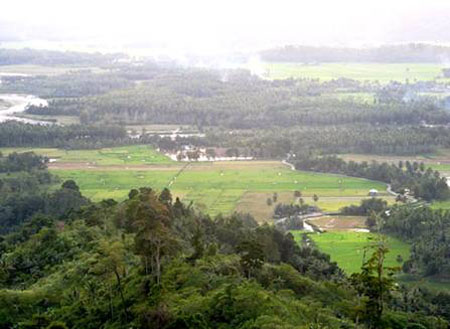
|
Above,
photo of Siocon’s rice lands, taken from the road from Canatuan in the town’s northeast mountainous portion. Below, a Siocon farmer with his harvest. Siocon’s achievement as top rice producer came even as a minority of residents have repeatedly claimed that TVIRD’s mining activities are a threat to the livelihood and produce of rice farmers down the plains. |
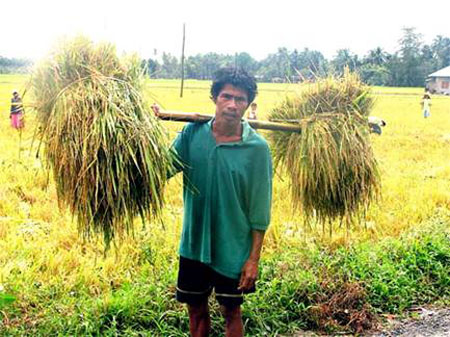
Siocon’s achievement as top rice producer came even as
a minority of residents have repeatedly claimed that TVIRD’s mining activities
are a threat to the livelihood and produce of rice farmers down the plains.
The company began producing gold and silver in the mountains of Canatuan in
July 2004 until April 2008, and started commissioning activities for copper
concentrate production last November. Those who oppose the company’s presence
say water that flows down from the highlands are contaminated with toxic chemicals
used in processing ore to extract minerals.
“Siocon has a total of 1,829 hectares of irrigated rice
lands and some 1,250 non-irrigated or rain-fed rice lands,” explained
Sebastian Ates, resident farm technician of the Office of the Municipal Agriculturist
for the past 15 years. “In all the years I have worked in this office,
I have not observed any reduction in our rice production.”
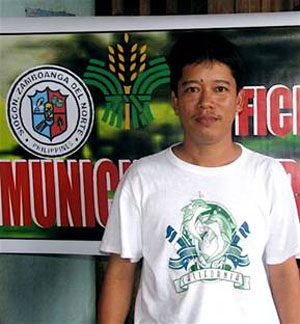
|
Above,
Siocon Municipal Agriculturist Jonathan Jaron and below, a bountiful rice field in Barangay Siay. There has never been a decrease in rice production in this town for the last 10. |
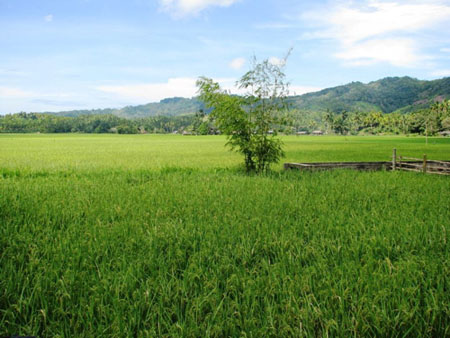
Asked about reports that rice production in his town may have
decreased because of large-scale mining activities in the upland portion of
Siocon, he shook his head: “Nobody has asked me anything about rice production
in the town for the past ten years!”
Fish and other marine life have actually began flourishing
again in the rivers of Siocon, including Lituban River where farmers source
water to irrigate his farms, since the company embarked, beginning 2003, on
a year-long environmental cleanup to rid Canatuan of the mercury and cyanide
tailings of illegal small-scale miners who operated in the area throughout the
‘90s until the early years of the new millennium.
Efren Lobrigas, owner and manager of a rice mill in Siocon,
said that as far as he can remember, rice production in his town has never decreased
since he started his business in 1990. He knows every farmer in the villages
of Siay, S. Cabral, Malipot, D. Sailila, Pisawak, and Bulacan.
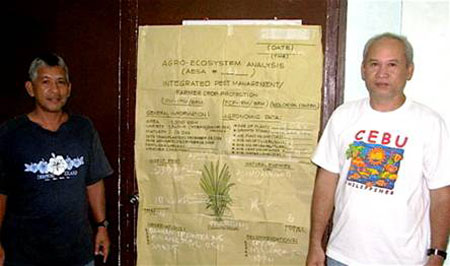
|
Above
right, Sebastian Ates, with fellow Siocon farm technician Nonoy Hotingjo. Below, rich rice paddies and corn fields are a common sight in Siocon. When asked about reports that rice production in his town may have decreased because of TVIRD’s mining activities in the upland portion of Siocon, Ates shook his head: “Nobody has asked me anything about rice production in the town for the past ten years!” |
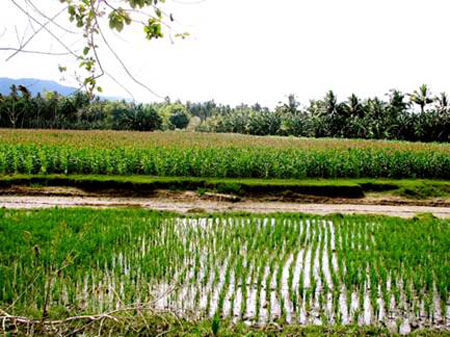
“The income in my rice mill is okay,” he related.
“Its return on investment remains very encouraging. There may have been
a decline in the number of farmers who are milling their palay here, but this
can be attributed to the fact that more rice mills have been put up in barangays
(smallest political unit in the Philippines) where rice production is big. Farmers
just want to have their palay milled in nearby mills to reduce their overhead
expense. It is not because we have less rice production.”
Ates, whose wife was born and raised in Siocon and who has
a piece of rice land of his own in this town, has been in charge of implementing
the government’s agriculture programs and projects concerning rice, including
the distribution of free fertilizers and seedlings. He is also the go-to guy
during seasons of pestilences or of droughts that can adversely affect rice
production.
While there has never been a decrease in rice production in
Siocon in the years he has been in his post, he said that based on experience,
rice production downturns can be attributed to several factors, among them high
cost of farm inputs like fertilizers and pesticides, as well as labor.
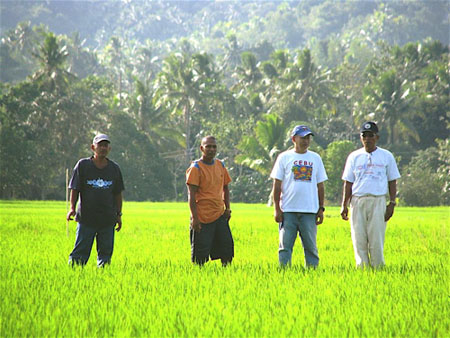
|
Above,
Sheldon Galos (in orange shirt), son of an anti-mining advocate, with Hotingjo (in black), Ates (in blue cap) and Malipot Barangay Chairman Romulo Moras (far right) Ates says Sheldon’s half-hectare farm which is planted with rice seedlings the former had distributed to farmers “will yield no less than three metric tons of rice”, which is quite productive. Below, carabaos cool themselves in one of Siocon’s water tributaries that also serve as irrigation system that supplies water to the rice fields. Water from Canatuan, TVIRD’s host community, flows down to the Siocon plains. |
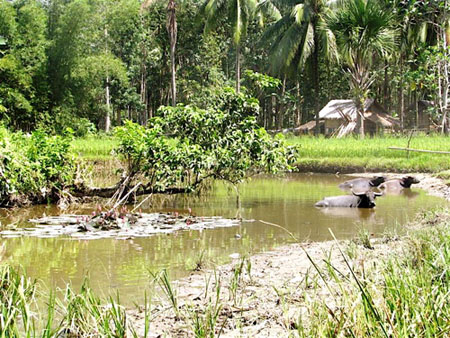
“Our estimated cost of production for a hectare of rice
land is P20,000, including labor,” he detailed. “If a farmer does
not have this amount, then he has a problem. He has to run to the loan sharks
for capital. If he cannot have the required capital, chances are that he would
reduce the number of hectares that he would work on for the entire cropping.
“Other factors include attacks of rodents and pests such
as stem borers or leaf hoppers,” he continued. “And let’s
not forget the natural calamities which are beyond our control. For instance,
Typhoon Frank last year destroyed a part of our irrigation system that supplies
the water needs of our rice lands in the southern part of the town. However,
if something goes wrong with the irrigation system in the southern part and
production is affected, production in the northern part always offsets the losses
because we have a reliable water supply for the rice lands in San Jose, Siay,
S. Cabral, Malipot, and Tagaytay.”
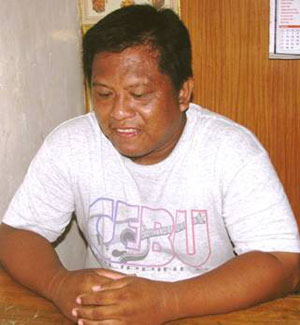
|
Above,
rice mill owner Efren Lobrigas says return on investment for his business remains “very encouraging.” “There may have been a decline in the number of farmers who are milling their palay here, but this can be attributed to the fact that more rice mills have been put up in barangays where rice production is big.” Below, fish and other marine life have began flourishing again in the rivers of Siocon, including Lituban River where farmers source water to irrigate their farms since TVIRD embarked, beginning 2003, on a year-long environmental cleanup. |
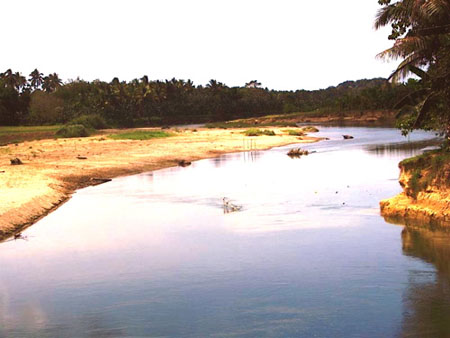
Ates took pride in saying that the latest NSIC RC-130 rice
seedlings that he had distributed to farmers in Siocon has shown encouraging
results as he showed the demonstration farm planted with this rice variety.
The 0.5 hectare farm owned by Sheldon Galos, son of Save Siocon Paradise Movement
leader and anti-mining activist Godofredo Galos, is “very promising.”
Ates is optimistic that this farm will yield no less than three metric tons
of rice.
He wishes that the government will give further attention to
the 199 hectares of non-irrigated rice lands in Barangays Tagaytay, M. Francisco
and Tibangao. “Rice farmers here are dependent on the rains. If we will
have a dry spell, they will not be able to plant rice.”
Andres Micubo, a municipal councilor and chairman of the Committee
on Agriculture agrees with Ates. Micubo, who also owns several hectares of rice
lands, said the harvest last year was slightly affected by Typhoon Frank. “If
not for Frank, I believe my harvest last year would have been higher compared
with 2007. It is, therefore, ridiculous to say that our rice production has
been affected. Our supply of water via our irrigation system is steady. We do
not have problems related to water. Our problems have to do with the high price
of farm inputs,” Micubo added. “At the height of fuel prices in
the last three years, the price of a sack of fertilizer reached P2,000, which
is way too much for small rice farmers!”
Ates believes subsidies for rice farmers should continue if
agriculture is to remain a vital cog in the country’s progress. “There
should always be free fertilizers, seedlings, and even pesticides so that farmers
will shoulder only the labor cost of production. This way, farmers will be encouraged
to plant more.” (Lullie Micabalo)
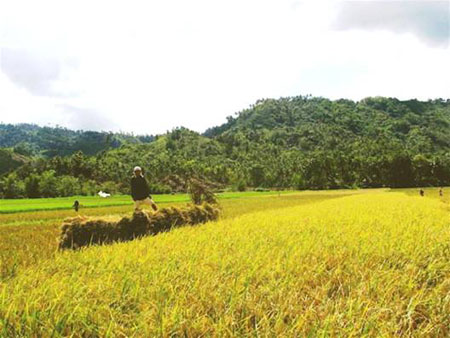
|
Harvest
time in Barangay Pisawak. |

